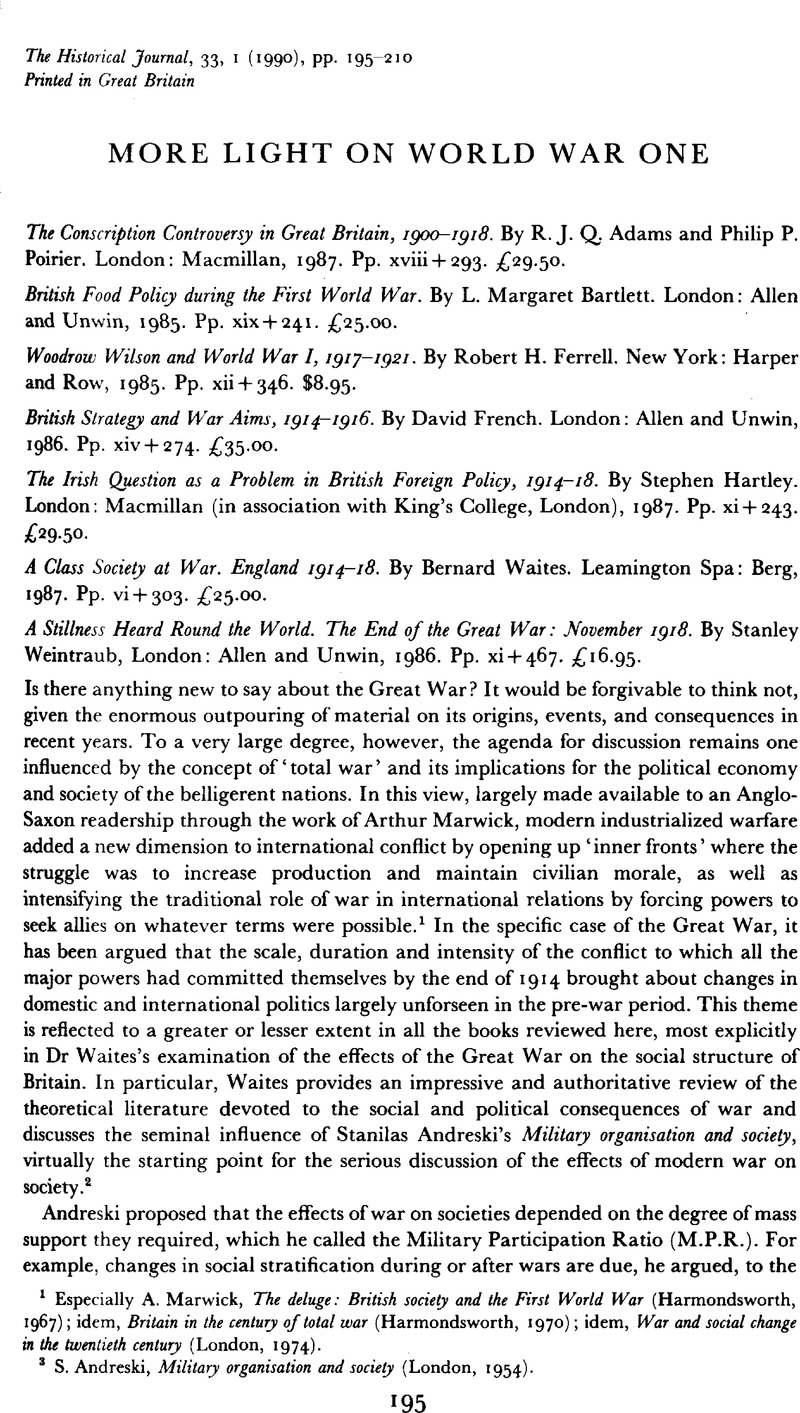Article contents
More Light On World War One
Published online by Cambridge University Press: 11 February 2009
Abstract

- Type
- Review Articles
- Information
- Copyright
- Copyright © Cambridge University Press 1990
References
1 Especially Marwick, A., The deluge: British society and the First World War (Harmondsworth, 1967)Google Scholar; idem, Britain in the century of total war (Harmondsworth, 1970); idem, War and social change in the twentieth century (London, 1974).
2 Andreski, S., Military organisation and society (London, 1954)Google Scholar.
3 R. Titmuss, ‘War and social policy’, in idem, Essays on ‘The Welfare State’ (London, 1958), pp. 75–87.
4 Beveridge, W. H., The pillars of security (New York, 1943), p. 108Google Scholar.
5 Abrams, P., ‘The failure of social reform, 1918–1920’, Past and Present, XXIV (1963), 57–62Google Scholar.
6 See Smith, H. L. (ed.), War and social change: British society in the Second World War (Manchester, 1986)Google Scholarfor recent discussion of the effects of the War on aspects of social policy; the fullest study of the political consequences remains Addison, P., The road to 1945: British politics and the Second World War (London, 1975)Google Scholar.
7 Calder, A., The people's war: Britain, 1939–45 (London, 1969)Google Scholarsought to demystify the Second World War from a broadly left-wing standpoint; his perspective is neatly encapsulated in his foreword to Grafton, P., You, you, & you The people out of step with World War II (London, 1981), pp. iv–xGoogle Scholar. For Pelling, see Pelling, H., Britain and the Second World War (London, 1970), pp. 320–6Google Scholar.
8 Macnicol, J., The movement for family allowances, 1918–45: a study in social policy development (London, 1980)Google Scholar.
9 Swenarton, M., Homes fit for heroes: the politics and architecture of early state housing in Britain (London, 1981), especially pp. 70–88Google Scholar.
10 Becker, J.-J., The Great War and the French people (English edn, Leangton Spa, 1985), p. 6Google Scholar.
11 See, for example, Marwick, A., ‘Problems and consequences of organizing society for total war’, in Dreisziger, N. F. (ed.), Mobilization for total war: the Canadian, American and British experience 1914–1918, 1939–1945 (Ontario, 1981)Google Scholarand Kocka, J., Facing total war: German society 1914–1918 (Leamington Spa, 1984)Google Scholar.
12 See French, D., British economic and strategic planning, 1905–1915 (London, 1982), pp. 155–60Google Scholar.
13 Becker, , Great War and the French people, pp. 15, 16Google Scholar.
14 Marwick, , Total war, pp. 11–17Google Scholar.
15 Matthew, H. C. G., McKibbin, R., Kay, J. A., ‘The franchise factor in the rise of the Labour Party’, English Historical Review XCI (1976), 736CrossRefGoogle Scholar.
16 Pugh, M., Electoral reform in war and peace (London, 1978), pp. 180–1Google Scholar.
17 See Porter, B., The origins of the vigilant state: the London metropolitan police special branch before the First World War (London, 1987), pp. 161–94Google Scholar, Morgan, J., Conflict and order: the police and labour disputes in England and Wales, 1900–1939 (Oxford, 1987), especially pp. 43–61, 148–87Google Scholar, and Kamm, R. A., ‘The Home Office, public order and civil liberties, 1880–1914’ (University of Cambridge, Ph.D. thesis, 1987)Google Scholar, ch. 7 and conclusion.
18 Howard, M., ‘Europe on the eve of the First World War’ in Evans, R. J. W. and von Strandman, H. Pogge (eds.), The coming of the First World War (Oxford, 1988), pp. 1–17, especially pp. 14–17Google Scholar.
19 Angell, Norman, The great illusion (London, 1910)Google Scholar. For the influence of ‘Angellism’ see Wallace, S., War and the image of Germany: British academics, 1914–1918 (Edinburgh, 1988), pp. 15–28Google Scholarand Weinroth, H., ‘Norman Angell and “The Great Illusion” An episode in pre-1914 pacificism’, The Historical Journal, XVII (1974)Google Scholar.
20 Howard, , ‘Europe on the eve’, pp. 9–14Google Scholar; Howard, notes that the more technical work by Ivan Bloch, La Guerre future aux points de vue technique, économique et poliiique (6 vols., Paris, 1898)Google Scholartranslated and summarized as Is war now possible? The future of War in its technical, economic and political relations (London and Boston, 1899)Google Scholarwas the major talking point of the professional military. His conclusions that modern weapons produced a deadlock on the battlefield which would destroy the fabric of the belligerent states, rendering war impossible, was widely discounted after the Russo-Japanese War had seen a decisive victory achieved with modern weaponry.
21 Ibid. pp. 11–12, 14–17; Wallace, , War and the image of Germany, pp. 24–42Google Scholar.
22 J. Holland Rose, ‘Britain's food supply in the Napoleonic war’ in idem, Napoleonic studies (London, 1906), pp. 204–21.
23 French, , British economic and strategic planning, pp. 170–2Google Scholar.
24 Waites, p. 232.
25 Waites, p. 234. The phrase is Geoffrey Best's.
26 Masterman, C. F. G., England after the war (London, 1922), p. xii, cited in Waites, p. 277Google Scholar.
27 Weintraub, p. 394.
- 2
- Cited by


